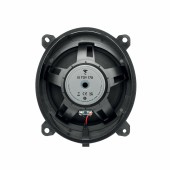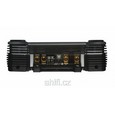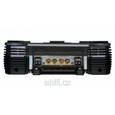Audison HV venti amplifier
2-channel, 2 x 200 / 1 x 800 into 4 Ω / 2 x 400 / 1 x 1300 W RMS into 2 Ω
More about the product
More about the product
We will help you with your purchase
- Use our consulting room
- You can return the goods to us within 14 days
- Try the product at our store
Audison HV venti amplifier
The Audison HV venti amplifier was born with a unique goal - to be the best amplifier in the world! HV venti is a stereo amplifier realized according to absolute Hi-End parameters. The development of the HV venti has introduced many technological innovations in the field of sound. The dual power supply allows the final stage to be set in two power output configurations, Hi Current or Hi Power. This feature allows for full speaker impedance matching and power manipulation. In order to admire this masterpiece created by Audison designers, the electronics are covered with a special scratch-resistant tempered glass and are illuminated by several white, red and blue LEDs located at strategic points.The main features of the Audison HV venti amplifier
- According to the definition of HiRes audio provided by JAS (Japan Audio Society - jas-audio.or.jp), the HV venti far exceeds the aforementioned 40kHz band with the analog requirement, providing an amazing 5 ÷ 75 kHz (@ -3 dB, 2 VRMS, 4 Ω).
- Revolutionary feature allowing user to select amplifier output power configuration and operating class.
- Fully balanced JFET differential preamplifier inputs with output buffer for control unit.
- Exclusive IGBT (Insulated Bipolar Transistor) circuits.
- Dual Mono design with four power supplies in Synchro PWM configuration.
- Signal switching is done exclusively by means of relays.
- Fully balanced input circuit.
- Power on a separate board to eliminate interference.
- "Dual Power" function to switch between Hi-Current and Hi-Power.
- 5mm aluminum chassis connecting the two side cooling channels.
| Catalog number | HV VENTI |
| Brand | Audison |
| Links | Official web presentation (English) |
| Number of amplifier channelsAmplifiers are divided into: - Monoblocks - 2-channel - 3-channel - 4-channel - 5-channel - 6-channel - multi-channel Each channel is used to power one speaker for the coaxial type, or one side if they are component speakers. Monoblock type amplifiers are mainly used for subwoofers. 2-channel are suitable for both subwoofers and, for example, the front pair of speakers in a car. 3-channel is used for front or rear speakers + subwoofer. 4-channel are used for front + rear speakers or 1 pair of speakers + subwoofer. 6 or 5-channel are used for 2 pairs of speakers + subwoofer, most often. Bridging means connecting the amplifier to a bridge, using the + pole from one channel and the - pole from the other channel. In most cases this is shown as "BRIDGED" on the amplifier. | 2 |
| Energy class of the amplifierAmplifiers are divided into two basic classes: analog and digital . Analog amplifiers (A/B) have higher consumption requirements, but usually have a more natural sound. Digital amplifiers (D) have significantly lower consumption and higher efficiency, but the sound may not be as faithful as with classic analog amplifiers. | A |
| RMS power into 4 ΩRMS power when loading speakers or subwoofer at 4 Ω. RMS power is the constant power of the amplifier and is one of the most important parameters when choosing an amplifier. | 2 x 200 / 1 x 800 W |
| RMS power into 2 ΩRMS power when loading speakers or subwoofer at 2 Ω. RMS power is the constant power of the amplifier and is one of the most important parameters when choosing an amplifier. | 2 x 400 / 1 x 1300 W |
| Harmonic Distortion (THD)Total harmonic distortion indicates how much the input signal is distorted in the amplifier. Distortions appear as overtones contained in the output signal. The proportion of originally absent parts of the signal is given as a percentage, typical values are between 0.001% and 0.5%. Distortion is measured in their power band. If it exceeds the limit of 0.7% from a certain power, it is the value of the output power of the given amplifier, from which it no longer plays without distortion and from which the distortion usually increases steeply, so that no further increase in power can be counted on. The lower the value, the better. | 0,05 % |
| Signal-to-noise ratioThe signal-to-noise ratio means that the output signal always contains noise. The signal-to-noise ratio expresses how much of this noise is compared to the useful signal. The so-called A value is given, which does not take deep and very high frequencies into account. This corresponds to the characteristic of human hearing, which is not so sensitive to deep frequencies, especially below 1 kHz. The higher the value, the better the amplifier is. | 100 dB |
| Input sensitivityIn order for the amplifier to perform its function correctly, it requires an input signal of a certain level, which is different for car radios. It is measured in "Volts" (e.g. 2 V, 4 V, etc.) The higher the value at the output of the pre-amplifier, or car radio, the less demands are placed on the power of the amplifier. However, the amplifier must allow this input sensitivity, and for that reason this value is also given for the amplifier. | 0,25 - 1,6 V |
| Socket input terminalsFerrule terminals allow better wiring contact to the amplifier. It is also a more secure form of terminals. If you are tightening the sleeve terminals, we recommend retightening them after 1 day, as the connected cable gradually compresses. | Ano |
| The value of the fuses on the amplifierFrom the value of the fuses on the amplifier, you can get a true picture of the real performance of the amplifier. | 100 A |
| Dimensions of the amplifier | 510 x 85 x 280 mm |
| Mass | 15 kg |
Product comments
Evaluation
ask us




